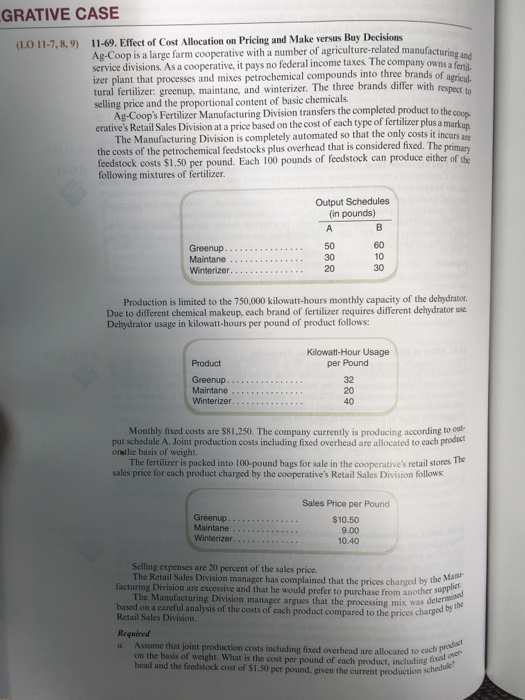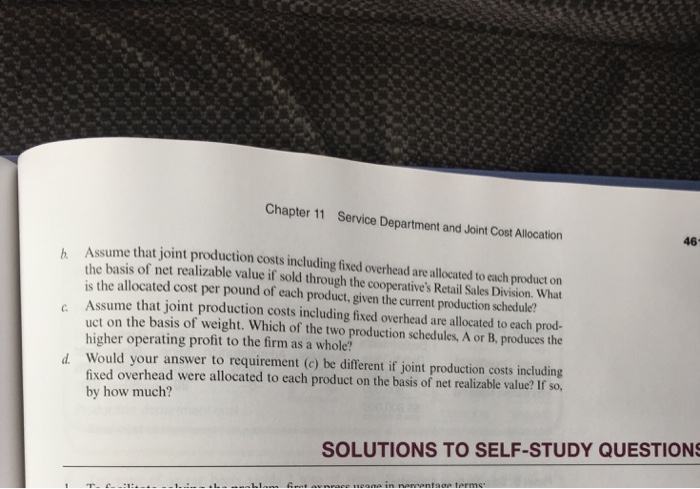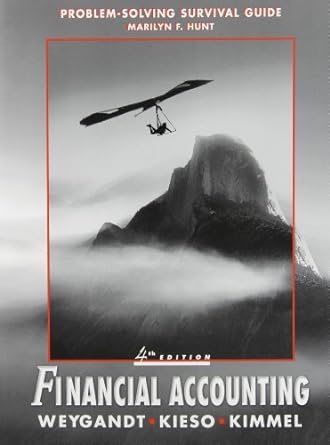GRATIVE CASE (LO 11-7,8,9) 11-69. Effect of Cost Allocation on Pricing and Make versus Buy Decisions rative with a number of agriculture-related manufacturin service divisions. As a cooperative, it pays no federal income taxes. The company izer plant that processes and mixes petrochemical compounds into three brands of tural fertilizer: greenup, maint selling price and the proportional content of basic chemicals owns a fertil. ane, and winterizer. The three brands differ with Manufacturing Division transfers the completed product to the erative's Retail Sales Division at a price based on the cost of each type of fertilizer plus a ma The Manufacturing Division is completely automated so that the only costs it incurs the costs of the petrochemical feedstocks plus overhead that is considered fixed. The feedstock costs $1.50 per pound. Each 100 pounds of feedstock can produce either of the following mixtures of fertilizer Output Schedules in pounds) Maintane . Winterizer 50 30 20 10 30 Production is limited to the 750,000 kilowatt-hours monthly capacity of the dehydrator. Due to different chemical makeup, each brand of fertilizer requires different dehydrator use Dehydrator usage in kilowatt-hours per pound of product follows: Kilowatt-Hour Usage per Pound 32 20 40 Product Greenup. Maintande Winterizer Monthly fixed costs are $81,250. The company currently is producing according to oul- put schedule A. Joint production costs including fixed overhead are allocated to each produ onsthe basis of weight. The fertilizer is packed into 100-pound bags for sale in the cooperative's retail stores sales price for each product charged by the cooperative's Retail Sales Division follows: Sales Price per Pound $10.50 9.00 10.40 Greenup Maintane Selling expenses are 20 percent of the sales price. The Retail Sales Division complained manager has complained that the prices charged by the facturing Division are excessive and that he would prefer to purchase from another The Manufacturing Division manager argues that the processing mix was deerb based on a careful analysis of the costs of each product compared to the prices cha Retail Sales Division. a. Assume that joint production costs including fixed overhead are allocated to each pt on the basis of weight. What is the cost per pound of each product, including head and the feedstock cost of $1.50 per pound, given the current production se GRATIVE CASE (LO 11-7,8,9) 11-69. Effect of Cost Allocation on Pricing and Make versus Buy Decisions rative with a number of agriculture-related manufacturin service divisions. As a cooperative, it pays no federal income taxes. The company izer plant that processes and mixes petrochemical compounds into three brands of tural fertilizer: greenup, maint selling price and the proportional content of basic chemicals owns a fertil. ane, and winterizer. The three brands differ with Manufacturing Division transfers the completed product to the erative's Retail Sales Division at a price based on the cost of each type of fertilizer plus a ma The Manufacturing Division is completely automated so that the only costs it incurs the costs of the petrochemical feedstocks plus overhead that is considered fixed. The feedstock costs $1.50 per pound. Each 100 pounds of feedstock can produce either of the following mixtures of fertilizer Output Schedules in pounds) Maintane . Winterizer 50 30 20 10 30 Production is limited to the 750,000 kilowatt-hours monthly capacity of the dehydrator. Due to different chemical makeup, each brand of fertilizer requires different dehydrator use Dehydrator usage in kilowatt-hours per pound of product follows: Kilowatt-Hour Usage per Pound 32 20 40 Product Greenup. Maintande Winterizer Monthly fixed costs are $81,250. The company currently is producing according to oul- put schedule A. Joint production costs including fixed overhead are allocated to each produ onsthe basis of weight. The fertilizer is packed into 100-pound bags for sale in the cooperative's retail stores sales price for each product charged by the cooperative's Retail Sales Division follows: Sales Price per Pound $10.50 9.00 10.40 Greenup Maintane Selling expenses are 20 percent of the sales price. The Retail Sales Division complained manager has complained that the prices charged by the facturing Division are excessive and that he would prefer to purchase from another The Manufacturing Division manager argues that the processing mix was deerb based on a careful analysis of the costs of each product compared to the prices cha Retail Sales Division. a. Assume that joint production costs including fixed overhead are allocated to each pt on the basis of weight. What is the cost per pound of each product, including head and the feedstock cost of $1.50 per pound, given the current production se








